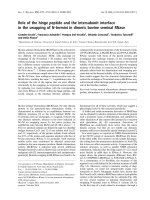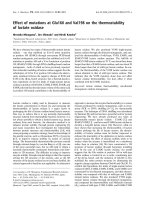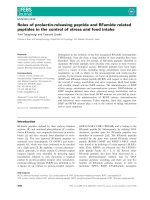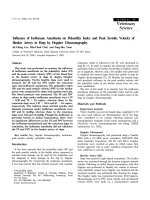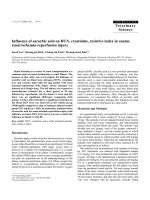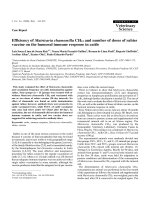Báo cáo khoa học: "Influence of on cutting methods and dates stump sprouting in Holm oak (Quercus ilex L) coppice" pdf
Bạn đang xem bản rút gọn của tài liệu. Xem và tải ngay bản đầy đủ của tài liệu tại đây (954.71 KB, 16 trang )
Original
article
Influence
of
cutting
methods
and
dates
on
stump
sprouting
in
Holm
oak
(Quercus
ilex
L)
coppice
M
Ducrey
M
Turrel
INRA,
Station
de
Sylviculture
Méditerranéenne,
Avenue
A
Vivaldi,
F-84000
Avignon,
France
(Received
10
February
1992;
accepted
11
May
1992)
Summary —
The
goals
of
this
study
were
to
compare
height
growth
of
stump
sprouts
in
Quercus
ilex
stools
cut
by
different
methods
at
various
times
during
the
year.
Four
cutting
methods
were
com-
pared:
chain
saw
at
ground
level
and
at
15
cm
above
ground,
axe,
and
’saut
du
piquet’
(’stump
breaking’).
Cuttings
were
carried
out
every
2
months
for
a
period
of
1
year.
Several
important
results
can
be
described
4
years
after
cutting.
Cuttings
performed
during
the
dormant
season
resulted
in
minimum
stool
mortality,
and
maximum
new
sprout
number,
height
and
diameter
growth.
An
excep-
tion
was
cutting
made
during
a
winter
frost
period.
Summer
cuttings
led
to
the
poorest
growth
which,
however,
tended
to
be
regained
in
subsequent
years.
Axe
and
chain
saw
cuttings
yielded
better
re-
sults
than
’saut
du
piquet’
cutting.
This
last
method
resulted
in
high
stool
mortality
and
both
fewer
and
smaller
sprouts.
Sprouts
appeared
to
be
more
numerous
and
grew
better
when
the
stools
initial-
ly
had
large
and
numerous
shoots.
Quercus
ilex
L
/ coppice
/ stump
sprout
/ cutting
method
/ cutting
date
Résumé —
Influence
des
méthodes
et
dates
d’exploitation
sur
la
régénération
par
rejets
de
souche
des
taillis
de
chêne
vert
(Quercus
ilex
L).
L’objectif
de
cette
étude
est
de
comparer
la
croissance
de
cépées
de
chêne
vert
(Quercus
ilex
L)
exploitées
par
différentes
méthodes,
à
diffé-
rentes
époques
de
l’année.
Quatre
méthodes
d’exploitation
ont
été
comparées :
tronçonneuse
au
ras
du
sol
et
à
15
cm
au-dessus
du
sol,
hache
et
«saut
du
piquet».
Les
exploitations
ont
été
faites
tous
les
2
mois
pendant
une
année
entière.
Les
principaux
résultats
obtenus
4
années
après
exploi-
tation
sont
les
suivants.
Les
exploitations
faites
hors saison
de
végétation
donnent
les
meilleurs
ré-
sultats
du
point
de
vue
de
la
survie
des
cépées
initiales,
du
nombre
et
de
la
croissance
en
hauteur
et
en
diamètre
des
nouveaux
rejets,
à
l’exception
des
exploitations
faites
en
période
de
gel
hivernal.
Les
exploitations
pendant
l’été
donnent
de
moins
bons
résultats
mais
il
semble
y
avoir
un
rattrapage
les
années
suivantes.
Les
exploitations
à
la
hache
et
à
la
tronçonneuse
donnent
de
meilleurs
résul-
tats
que
la
méthode
du
«saut
du
piquet»
qui
cumule
une
mortalité
importante
des
cépées,
et
des
re-
jets
plus
petits
et
en
nombre
moins
important.
II
apparaît
enfin
que
les
rejets
sont
d’autant
plus
nom-
breux
et
vigoureux
que
les
cépées
initiales
ont
beaucoup
de
brins
et
que
ceux-ci
sont de
grande
dimension.
Quercus
ilex
L
/ taillis
/ rejets
de
souche
/ méthode
de
coupe / date
d’exploitation
INTRODUCTION
Coppice
regeneration
occurs
through
stump
sprouting
rather
than
sexual
repro-
duction.
This
is
the
basis
for
managing
most
of
the
Quercus
ilex
stands.
It
is
thus
essential
that
clearcutting
for
coppice
re-
generation
be
performed
under
the
best
conditions
to
optimize
density
and
growth
of
the
new
sprouts
which
will
constitute
the
new
forest.
A
"coppice"
is a
forest
stand
composed
of
stools.
A
"stool"
is
the
entire
physiological
system
comprised
of
a
"clump"
of
1
or
sev-
eral
"shoots"
(=
stems)
and
the
attached
un-
derground
system.
After
coppicing,
several
"stubs"
(the
base
of
the
cut
shoots)
remain
on
the
stump.
The
"stump"
is
the
under-
ground
part
of
the
stool
remaining
attached
to
the
roots
after
coppicing.
The
sprouting
of
adventitious
or
dormant
proventitious
buds
on
the
stubs
produces
numerous
"stump
sprouts"
which
will
become
the
shoots
of
the
new
clump.
This
process
is
repeated
each
time
the
stand
is
coppiced.
It
is
often
impossible,
when
studying
a
stool,
to
determine
how
many
times
it
has
been
coppiced,
and
the
age
of
the
underground
part
of
a
stool
is
often
unknown.
Cutting
tools
and
methods
in
Quercus
ilex
coppices
have
changed
over
the
years.
Former
techniques
such
as
’coupe
entre
deux
terres’
(cutting
just
under
ground
level)
and
’saut
du
piquet’
(stump
breaking)
(Regimbeau
1879,
de
Larminat
1893),
widely
employed
at
the
end
of
the
19th
century,
along
with
the
use
of
axes
and
scythes,
all
but
vanished
50
years
ago;
the
use
of
chain
saws
is
now
com-
mon.
Cutting
dates
may
vary
for
coppice,
even
though
cuttings
are
usually
performed
dur-
ing
the
dormant
season.
However,
cuttings
made
during
the
sap
ascension
period
at
the
beginning
of
the
growing
season -
as
was
commonly
done
when
the
holm
oak’s
bark
was
used
for
tannin
production
-,
dur-
ing
summer
droughts,
or
winter
frosts
were
and
still
are
numerous
and
frequent.
Few
references
appear
in
the
literature
comparing
cutting
methods
and
these
only
examine
chestnut
(Phillips,
1971;
Caba-
nettes
and
Pagès,
1986,
1990)
or
poplars
(Crist
et al,
1983).
Results
being
different
from
1
species
to
another
and
with
no
in-
formation
on
Quercus
ilex
reaction,
more
work
is
needed
on
that
species.
References
on
cutting
height
are
more
numerous:
Belanger
(1979)
for
sycamore,
De
Bell
and
Alford
(1972),
Crist
et
al
(1983)
for
poplar,
Harrington
(1984)
for
red
alder,
Cabanettes
and
Pagès
(1990)
for
chestnut,
Piskoric
(1963)
for
holm
oak
and
Martinez
and
Martin
(1985)
for
eucalyptus
among
others.
Results
vary
from
1
species
to
the
other
and
need
to
be
carefully
stud-
ied.
Coppicing
dates
were
sometimes
stud-
ied
in
relation
either
to
stool
physiology
(Riedacker,
1973;
Dubroca,
1983;
Mac-
Donald
and
Powell,
1985),
bud
origin
(Bar-
tet,
1890;
Harmer,
1988),
bud
activity
or
dormancy
(Bartet,
1890;
Warnier,
1931;
Wenger,
1953;
Riedacker,
1973),
or
photo-
periodic
(Wenger,
1953;
Wargo,
1979)
or
hormonal
(Avery
et
al,
1937;
Vogt
and
Cox
1970;
Riedacker
1973)
mechanisms
con-
trolling
bud
activity.
Some
studies
dealt
with
coppice
yield
in
relation
to
coppicing
date
(Ciancio
and
Morandini,
1971;
Cian-
co,
1977).
However,
there
are
only
a
few
studies
using
recent
advances
and
tech-
niques
of
modern
physiology
(Blake
and
Raitanen,
1981;
Ferm
and
Kauppi,
1990).
In
Quercus
ilex,
little
is
known
of
the
functioning
of
coppice
and
more
particular-
ly
of
stools
which
are
the
real
biological
units
for
coppice.
Only
extremely
old
refer-
ences
(Bedel
1866,
Regimbeau
1879,
de
Larminat
1893)
are
available
for
this
spe-
cies.
This
is
the
reason
why
we
started
studying
the
impact
of
partial
cuttings
(thin-
ning)
or
clear
cuttings
on
coppices
(Du-
crey,
1988).
The
first
results
concerned
coppice
behaviour
when
thinnings
were
performed
with
variable
intensity
in
differ-
ent
age
stands
(Ducrey
and
Toth,
1992).
The
aim
of
the
present
paper
is
to
study
the
influence
of
both
cutting
methods
and
dates
on
number
and
growth
of
newly
formed
sprouts.
Cutting
methods
compare
traditional
methods
such
as
’saut
du
pi-
quet’
(described
in
Materials
and
methods)
and
axe
with
the
modern
chain
saw
meth-
od.
Chain
saw
cutting
height
was
also
con-
sidered.
Cuttings
were
performed
every
2
months
for
a
year.
Our
goal
is
not
to
rec-
ommend
1
method
over
another
because
chain
saw
coppicing
is
nowadays
the
only
method
used.
Our
objective
is
to
compare
these
different
methods
and
to
determine
their
short-term
effect
on
coppice
sprout-
ing.
We
will
try
to
understand
the
influence
they
might
have
on
the
long
term
subsis-
tence
and
vigour
of
holm
oak
coppice.
MATERIAL
AND
METHODS
The
stand
The
studied
stand
is
located
in
the
communal
for-
est
of
La
Bruguière,
5
km
north
of
Uzès
(Gard,
France).
This
forest
grows
on
a
relatively
flat
limestone
plateau
at
250-300
m
elevation.
It
is
typical
of
Quercus
ilex
forests
in
this
region
(Gar-
rigues
du
Gard):
annual
rainfall
averages
1
000
mm
and
summer
drought
does
not
exceed
2
months.
Since
1881,
the
harvest
method
used
has
been
simple
coppicing
with
a
25-30
year
ro-
tation.
Previously,
rotations
were
shorter,
less
than
20
years,
and
coppice
was
grazed
from
10
years
after
coppicing
to
the
next
coppicing
time.
The
studied
stand
is
part
of
compartment
10
of
this
forest
and
has
an
area
of
0.7
ha.
In
1985,
the
inventory
revealed
an
average
age
of
30
years
for
the
compartment.
Preceding
coppic-
ings,
around
1955
and
1930,
were
performed
with
a
combination
of
’axe’
and
’saut
du
piquet’
techniques.
Experimental
design
The
experimental
design
(Ducrey
and
Turrel,
1986)
consisted
of
6
adjacent
plots
where
all
stools
with
at
least
1
shoot
whose
girth
50
cm
above
ground
was
at
least
10
cm
were
recorded
shoot
by
shoot.
Girth
at
50
cm
was
measured
for
all
recorded
shoots.
Total
number
of
shoots
in
each
parent
stool
was
used
to
distribute
stools
according
to
shoot
number
classes,
and
mean
girth
of
shoots
in
each
stool
was
used
to
distribute
stools
according
to
shoot
girth
class-
es.
Stools
were
comprised
of
1-25
shoots.
A
histogram
of
distribution
of
the
number
of
stools
according
to
their
number
of
shoots
showed
an
exponential
decrease.
Length
of
the
longest
shoot
of
each
stool
was
also
measured.
The
six
plots
were
shared
among
2
relatively
homoge-
neous
blocks.
Their
dendrometric
characteristics
are
shown
in
table
I.
Each
plot
was
divided
into
2
sub-plots
and
each
of
the
12
sub-plots
was
a
working
unit:
every
2
months
for
a
year
(from
September
1985
to
July
1986),
2
sub-plots
(one
in
each
block)
were
cut.
Figure
1
shows
the
climatic
con-
ditions
throughout
the
cutting
period.
For
each
cutting,
4
methods
were
used:
chain
saw
at
ground
level
(S0),
chain
saw
at
15 cm
height
(S15),
axe
at
ground
level
(A)
and
’saut
du
piquet’
(SP).
’Saut
du
piquet’
is
an
old
technique
that
combines
cutting
the
shoot
at
50
cm
and
hor-
izontally
knocking
off
the
remaining
part
of
the
shoot
where
it
is
attached
to
the
stump
with
the
flat
end
of
an
axe
or
sledge
hammer
to
detach
the
shoot from
the
stump.
The
objective
of
this
method
was
to
rejuvenate
stools
through
individu-
alization
of
shoots
and
roots
of
the
same
stool
by
stump
division
(Regimbeau,
1879).
In
a
given
sub-plot,
each
cutting
method
was
applied
on
9
stools
selected
for their
shoot
num-
ber
and
mean
shoot
girth.
Nine
stool
types
were
defined
using
3
shoot
classes
(1
shoot,
2-3
shoots,
4-7
shoots)
and
3
girth
classes
(10-15
cm,
15-20
cm
and
20-25
cm).
In
each
of
these
types,
4
stools
were
randomly
chosen
and
cut
using
1
of
each
the
cutting
methods.
Additional
stools,
with
higher
shoot
number
or
larger
shoots,
were
selected
and
cut
by
S0
or
S15
methods
for
a
better
study
of
initial
stool
in-
fluence
on
stump
sprouting.
They
belonged
to
shoot
classes
4
(8-10
shoots)
and
5
(more
than
10
shoots)
and
girth
classes
4
(25-30
cm)
and
5
(more
than
30
cm).
In
each
sub-plot,
an
average
of
45
stools
were
identified.
Five
hundred
and
forty-six
stools
from
a
total
of
1290
stools
were
selected
for
the
whole
experimental
design.
Observations
and
measurements
On
half
the
plots
(block
1),
sprouting
dates
were
noted
every
15
days
from
May
to
October
1986;
the
first
sprouts
began
to
appear
only
at
the
be-
ginning
of
the1986
growing
season.
At
the
end
of
each
of
the
first
2
growing
sea-
sons,
the
importance
of
sprouting
was
estimated
by
measuring
the
space
the
new
stools
occupied.
Stool
volume
and
crown
area
were
estimated
by
measuring
total
stool
height
and
diameter.
Mean
canopy
height
was
estimated,
and
long-
est
sprout
length
of
each
stool
was
measured
for
4
consecutive
years,
in
each
stool.
Each
stool
was
recorded
at
the
end
of
1989
by
measuring
di-
ameters
at
50
cm
above
ground
of
all
sprouts
with
a
diameter
greater
than
or
equal
to
1
cm.
All
sprouts
were
inventoried
on
one
sub-plot.
RESULTS
Data
were
analyzed
using
a
3-way
analy-
sis
of
variance:
’cutting
method’,
’cutting
date’
and
’block’.
Neither
block
nor
interac-
tion
effects
were
significant.
Thus,
only
the
results
for
’cutting
method’
and
’cutting
date’ effects
are
described
below.
Dynamic
study
of
coppice
regeneration
Sprouting
was
observed
between
May
and
October
1986 because
sprouting
did
not
start
before
the
beginning
of
the
1986
growing
season,
even
for
stools
cut
in
Sep-
tember
1985.
Observations
were
only
made
within
block
1.
Sprouting
dynamics
were
expressed
by
the
percentage
of
new
clumps
with
optimun
development
(ie
more
than
10
sprouts
over
10
cm
in
length
on
each
stub
of
a
stool)
at
a
given
date
(fig
2).
No
differences
occurred
during
Septem-
ber,
November
and March
cuttings:
well-
developed
clumps appeared
as
early
as
the
second
half
of
May
1986 and
90%
of
all
stools
had
reached
this
stage
by
the
end
of
July
1986.
Stools
cut
in
May
1986,
ie
when
sprout
growth
usually
begins
for
Quercus
ilex,
had
reached
the
same
devel-
opmental
stage
1
month
later.
Only
73%
of
stools
cut
in
January
produced
well-
developed
young
clumps.
This
was
due
to
climatic
conditions
during
the
first
half
of
February
where
the
mean
of
minimum
tem-
peratures
was
-2 °C
and
absolute
mini-
mum
temperature
was
-15 °C.
After
the
July
1986
cutting,
sprouts
appeared
as
early
as
the
beginning
of
September
and
54%
of
the
stools
were
well-developed
by
the
end
of
October.
Yearly
measurements
of
stools
showed
that
differences
among
cutting
dates
in
clump
development
during
the
first
growing
season
were
the
same
for
all
measured
variables
(fig
3):
mean
and
maximum
height,
stool
crown
area
and
volume.
Stools
cut
in
July
progressively
regained
their
initial
growth
loss
in
subsequent
years.
However,
general
tendencies,
par-
ticularly
those
linked
with
February
1986
frosts,
still
persisted
after
4
years.
Coppice
behaviour
was
more
thorough-
ly
studied
during
the
winter
of
1989-1990.
Influence
of cutting
methods
Cutting
methods
influenced
the
number
of
living
stools
4
years
after
coppice
regener-
ation.
Mortality
was
3.6%
for
S0,
3.8%
for
S15,
1.6%
for
A
and
14.8%
for
SP
(fig
4).
axe
method
apparently
disturbed
stool
activity
the
least.
Chain
saw
cuttings
pro-
duced
somewhat
poorer,
but
not
signifi-
cantly
different
results.
No
difference
was
observed
between
the
2
cutting
heights.
The
’saut
du
piquet’
method
resulted
in
the
greatest
stool
mortality.
Data
analysis
showed
that
small
stools
cut
in
January
were
the
most
negatively
affected
by
this
method.
Table
II
summarizes
cutting
method
ef-
fects
on
stool
growth,
ie
mean
canopy
height,
longest
sprout
length,
number
of
sprouts
over
1
cm
in
diameter,
mean
diam-
eter
of
these
sprouts
and
largest
sprout
di-
ameter.
Number
of
sprouts
per
stool
varied
be-
tween
7.6
and
8.2
for
the
S0,
S15
and
A
methods
and
was
4.4
for
the
’saut
du
pi-
quet’
method,
which
was
significantly
dif-
ferent
from
the
first
3
methods.
Heights
were
slightly
greater
for
S15
and
slightly
smaller
for
SP.
No
significant
differences
were
found
for
diameters
from
1
method
to
the
other.
For
a
more
detailed
analysis
of
sprout-
ing
dynamics
within
each
stool,
the
diame-
ter
of
all
shoots
with
a
height
over
50
cm
were
measured
at
the
end
of
1989
in
one
sub-plot.
For
this
analysis,
10
stools
were
measured
for
each
cutting
method
(table
III).
The number
of
large
sprouts
(diameter
over
1
cm)
was
comparable
to
that
found
for
the
whole
experimental
design,
al-
though
there
were
differences
in
the
total
number
of
sprouts.
Large
sprouts
repre-
sented
1/3
of
the
total
for
ground
level
chain
saw
and
axe
cuttings,
but
only
1/4
for
chain
saw
at
15
cm
and
’saut
du
piquet’
cuttings.
Histograms
in
figure
5
specify
these
re-
sults
and
show
the
large
number
of
small
diameter
sprouts
in
stools
cut
using
the
S15
method
as
well
as
the
negative
effect
of
the
’saut
du
piquet’
method
on
sprout
number
and
size.
Influence
of cutting
dates
Cutting
dates
did
not
directly
influence
stool
mortality
(fig
4).
However,
observed
trends
showed
that
mortality
increased
when
cuttings
were
made
in
May,
July
and
Sep-
tember
during
the
growing
season
and
de-
creased
when
made
in
November
and
March
outside
the
growing
season.
Cuttings
in
January
were
followed
by
frost
and
wind
which
may
have
led
to
high
mortality.
Cutting
dates
generally
had
a
highly
sig-
nificant
effect
(1%
level)
for
all
the
vari-
ables
characterizing
stool
growth
(table
IV).
Number
of
sprouts
per
stool
was
the
highest
for
March
(9.5)
and
November
(8.4)
cuttings
and
the
lowest
for
July
(5.6)
cuttings.
Mean
and
maximum
height
fol-
lowed
similar
trends:
the
highest
for
March
cuttings
followed
by
May
and
November
cuttings
and
the
lowest
for
January
and
September
cuttings.
Mean
and
maximum
diameters
were
less
variable,
and
significantly
larger
sprouts
were
only
observed
for
March
cuttings.
In
conclusion,
it
seems
that
March
and
No-
vember
cuttings
were
the
most
favourable
for
sprout
growth.
On
the
contrary,
winter
cutting,
in
conjunction
with
frost,
reduced
both
sprout
number
and
height
growth.
Re-
sults
from
cuttings
made
during
the
growing
season,
particularly
in
July
and
September,
were
average
to
poor.
Influence
of initial
stool
characteristics
Individual stool
characteristics
prior
to
cutting
were
used
to
stratify
the
stool
sam-
ple
based
on
the
following
2
criteria:
mean
girth
of
shoots
within
a
stool
(girth
class)
and
number
of
shoots
per
stool
(shoot
class).
Mortality
was
significantly
higher
for
’1-
shoot’
stools
and
aslo
tended
to
be
higher
for
stools
with
mean
shoot
girth
between
10
and
15
cm
(fig
4).
’One-shoot’
stools
could
be
true
coppice
stools,
or
may
have
grown
from
seeds,
or
may
come
from
root
suckers.
In
the
latter
cases,
’saut
du
pi-
quet’
cutting
practically
removed
the
stool
from
the
ground
and
led
to
a
high
mortality.
Results
from
the
2-way
analysis
of
vari-
ance
(’shoot
class’
and
’girth
class’)
con-
ducted
on
data
from
stools
cut
using
the
S0
method
are
given
in
table
V.
Except
for
mean
diameter
where
no
’shoot
class’
ef-
fect
could
be
demonstrate,
effects
were
significant
in
all
other
cases
and
no
inter-
action
was
found
between
the
2
factors.
For
each
of
the
5
studied
variables,
mean
values
per
class
increased
regularly
from
class
1
to
class
5
both
for
shoot
classes
and
girth
classes.
Thus,
when
the
initial
stool
had
more numerous
and
larger
shoots,
subsequent
sprouts
were
more
nu-
merous
and
showed
greater
growth.
This
result
is
confirmed
by
the
analysis
con-
ducted
on
individual
characteristics
of
ini-
tial stools.
New-clump
characteristics
such
as
num-
ber
of
sprouts,
mean
and
maximum
sprout
diameter,
mean
and
maximum
sprout
length
were
correlated
to
individual
charac-
teristics
of
initial
stools:
number
of
shoots,
mean
shoot
girth,
mean
shoot
basal
area,
total
basal
area
of
the
stool
and
length
of
the
longest
shoot
of
the
stool
(table
VI).
Only
data
from
chain
saw
at
ground
level
cuttings
were
investigated
due
to
large
var-
iability
of
the
156
stools
cut
by
this
meth-
od.
Number
of
sprouts
was
correlated
to
to-
tal
basal
area
and
shoot
number
(r >
0.8).
Sprout
length
and
maximum
sprout
diame-
ter
appeared
to
be
correlated
with
basal
area
and
height
of
the
initial
stool,
ie
with
site
fertility,
but
correlation
coefficients,
were
relatively
low.
Low
variability
of
mean
sprout
diameter
could
explain
low
correla-
tion
with
initial
stool
characteristics.
DISCUSSION
AND
CONCLUSION
Impact
of
cutting
date
Cutting
date
affected
sprouting
date,
sprout
numbers,
and
sprout
growth.
These
results
are
comparable
to
those
obtained
by
others
(Bartet,
1890;
Warnier,
1931;
Wenger,
1953;
Riedacker,
1973).
They
ob-
served
that
when
stools
were
cut
in
late
summer
or
fall,
they resprouted
only
the
following
year.
When
cutting
was
per-
formed
earlier,
even
the
beginning
of
sum-
mer,
sprouting
followed
immediately.
In
this
study,
however,
there
was
a
1-month
lag
for
the
May
cutting
and
a
one
and
a
half
month
lag
for
the
July
cutting.
Harmer
(1988)
referred
to
a
bud
dormancy
for
summer
cutting,
which
only
cold
winter
temperatures
could
remove.
Late
summer
sprouting
may
be
dependent
upon
summer
climatic
conditions
as
well,
particularly
soil
water
reserves,
since
drought
can
increase
bud
dormancy.
Riedacker
(1973)
reacher
similar
conclusions
for
eucalyptus.
This
results
of
this
study
were
in
agree-
ment
with
results
obtained
by
other
au-
thors
for
sprout
number
and
growth:
when
cutting
was
performed
during
the
growing
season,
fewer
sprouts
with
weaker
growth
appeared
per
stool;
the
most
favourable
cutting
period
for
sprouting
and
sprout
de-
velopment
was
right
before the
beginning
of
the
growing
season
(March
cutting
in
this
study).
However,
except
for
the
January
cutting
where
climatic
conditions
could
be
respon-
sible
for
the
observed
differences,
cuttings
performed
outside the
growing
season
were
satisfactory.
Measurements
of
stool
height,
volume,
and
crown
area
conducted
in
previous
years
demonstrated
that
discrepancies
be-
tween
cutting
dates
appeared
immediately
in
the
first
growing
season
and
were
still
visible
during
the
following
years
regard-
less
of
cutting
method.
Exceptions
were
May
and
July
cuttings
where
a
positive
compensation
occurred
the
following
year.
The
negative
effect
of
winter
cutting
must
certainly
be
related
to
sensitivity
of
holm
oak
to
cold
temperatures
which
has
already
been
mentioned
by
Bedel
in
1866
and
by
Regimbeau
in
1879.
Desiccation
by
frost
of
the
stump’s
uppermost
section
and
destruction
of
various
tissues
could
explain
the
differences
observed
between
January
cuttings
and
other
cuttings
outside the
growing
season.
In
July
cuttings,
summer
drought
was
probably
a
limiting
factor,
since the
best
re-
sults
(November
and
March
cuttings)
were
obtained
when
cutting
was
followed
by
rain.
However,
strong
sunlight
and
high
temperatues
could
also
induce
desiccation
of
the
uppermost
stump
tissues
and
de-
struction
of
dormant
buds.
Impact
of
cutting
method
No
significant
difference
in
sprout
number,
height
or
diameter
could
be
demonstrated
between
’axe’
and
’chain
saw
at
ground
level’
methods.
Crist
et
al
(1983)
reached
similar
conclusions
when
comparing
the
ef-
fects
of
cutting
methods
using
saw
or
prun-
ing
shear
on
sprout
number
and
growth
in
poplars.
Cabanettes
and
Pagès
(1990)
ob-
served
a
positive
effect
of
the
axe
method
over
the
chain
saw
method
on
sprout
growth
in
chestnut,
but
this
effect
could
be
the
result
of
a
higher
cutting
position
in
the
axe
method.
Phillips
(1971)
observed
a
significant
positive
effect
of
the
axe
meth-
od
for
the
same
species.
Our
study
showed
that
stool
mortality
was
nominally
but
non-significantly
reduced
when
stools
were
cut
with
the
axe.
The
’saut
du
piquet’
technique
differed
significantly
from
the other
methods.
Sprout
number,
height
and
diameter
were
smaller
than
with
other
cutting
methods.
One
of
the
goals
of
this
method
was
to
de-
crease
sprout
numbers
within
stools
in
or-
der
to
decrease
sprout
competition
(Re-
gimbeau,
1879;
Des
Chesnes,
1892).
Our
results
did
not
support
this
expectation.
Sprout
height
growth
decreased
along
with
sprout
number,
and
stool
mortality
was
higher
in
the
’saut
du
piquet’
treatment.
This
technique
may
be
harmful
to
stool
physiology
and
weaken
the
stool.
The
neg-
ative
effect
seemed
to
be
accentuated
by
unfavourable
climatic
conditions:
among
the
8
stools
cut
in
January
that
died
the
first
year,
6
had been
cut
using
the
’saut
du
piquet’
method.
Historically,
this
technique
was
used
to
rejuvenate
stools
through
individualization
of
shoots
and
related
roots
by
stump
divi-
sion.
Regimbeau
(1879)
concluded
that
this
was
difficult
to
accomplish,
as
we
dis-
covered
ourselves,
and
could
not
be
used
too
often.
Our
study
failed
to
demonstrate
the
1
supposedly
interesting
by-product
of
this
method:
the
appearance
of
root
suck-
ers.
Impact
of
cutting
height
The
number
of
small-diameter
sprouts
ap-
peared
to
be
higher
on
stools
cut
with
a
chain
saw
15
cm
above
ground
than
at
ground
level,
although
large
sprouts
ap-
peared
in
equal
quantities.
Thus,
cutting
height
had
an
effect
on
sprout
type
rather
than
on
the
number
of
dominant
sprouts.
Several authors
have
observed
a
posi-
tive
correlation
between
sprout
number
and
cutting
height:
Belanger
(1979)
on
sy-
camore,
de
Bell
and
Alford
(1972)
and
Crist
et
al
(1983)
on
poplar,
Harrington
(1984)
on
red
alder,
Cabanettes
and
Pagès
(1990)
on
chestnut
and
Martinez
and
Martin
(1985)
on
eucalyptus.
Howev-
er,
results
in
oaks
differ.
Piskoric
(1963)
observed
that
sprouting
intensity
on
Quer-
cus
ilex
was
not
dependent
on
cutting
height.
Roth
and
Hepting
(1943)
demon-
strated
that
cutting
height
had
little
influ-
ence
on
sprouting
in
several
oak
species
since
most
sprouts
appeared
at
the
base
of
cut
shoots.
Similarly,
our
study
showed
that
mean
sprout
length
was
not
significantly
greater
for
stools
cut
at
15
cm
above
ground
(118
cm)
than
for
stools
cut
at
ground
level
(111
cm),
4
years
after
cutting.
These
con-
clusions
are
similar
to
those
of
Piskoric
(1963)
on
holm
oak,
de
Bell
and
Alford
(1972)
on
poplar,
Belanger
(1979)
on
sy-
camore
and
Cabanettes
and
Pagès
(1986)
on
dominant
sprouts
of
chestnut.
Howev-
er,
Khan
and
Tripathi
(1989)
found
that
sprout
growth
of
4
species
from
an
Hima-
layan
tropical
wet
forest
increased
with
cutting
height.
Impact
of
initial
stool
characteristics
The
originality
of
our
work
was
to
consider
stubs
not
as
individuals
but
as
a
part
of
a
whole
stool.
It
was
sometimes
difficult
to
determine
what
stool
a
shoot
belong
to.
This
may
explain
great
data
variability
in
the
2-way
variance
analysis
(table
V)
and
low
correlation
coefficients
between
char-
acteristics of
parent
stools
and
young
clumps
(table
VI).
However,
it
appeared
that
when
the
initial
stool
had
more
numer-
ous
and
larger
shoots,
subsequent
sprouts
were
more
numerous
and
showed
grater
growth.
Cabanettes
and
Pagès
(1986,
1990),
who
also
worked
at
a
whole-stool
level,
found
that
growth
of
new
sprouts
was
posi-
tively
related
to
size
and
number
of
stubs
of
the
initial
stool.
Other
similar
results
may
be
found
in
the
literature
even
if
the
authors
generally
worked
at
a
stub
level
and
not
a
whole-stool
level.
Sprouting
is
linked
to
stub
size
and
age
(Blake
and
Rai-
tanen,
1981).
In
some
cases
and
for
some
species,
this
relationship
is
positive
as
found
by
Wenger
(1953)
for
sweetgum
or
Belanger
(1979)
for
sycamore.
In
other
cases,
a
negative
relationship
was
found
by
Roth
and
Hepting
(1943)
for
5
oak
spe-
cies
or
Johnson
(1975)
for
red
oak.
Moreover,
stub
size
is
often
positively
related
to
age,
and
aging
negatively
affects
sprouting
(Blake
1981).
So,
it
may
be
con-
cluded
in
some
cases
that,
for
a
given
stub
age,
sprouting
is
positively
related
to
stub
size,
and
that
sprouting
usually
decreases
with
stub
age
after
a
given
species-
dependant age.
In
our
study,
coppicing
rotations
being
30
years,
shoots
were
still
young
at
coppic-
ing
time
and
stub
size
had
a
positive
effect
on
number
and
growth
of
stump
sprouts.
However
a
negative
additional
effect
could
be
due
to
aging
and
senescence
of
the
stool
root
system.
Silvicultural
consequences
Current
results
only
covered
4
growing
seasons
after
cutting.
Future
observations
will
be
necessary
for
greater
accuracy.
Particularly,
long
term
response
of
coppice
to
different
coppicing
methods
should
be
analyzed
during
a
whole
rotation.
The
same
studied
stand
should
also
be
cop-
piced
with
the
same
techniques
for
two
or
more
rotations.
Several
observations
are
already
possi-
ble.
Since
very
few
differences
were
shown
between
’axe’
and
’chain
saw
at
ground
level’
cutting
methods,
holm
oak
coppice
development
was
probably
very
lit-
tle
affected
by
using
chain
saws
rather
than
axes
for
coppice
regeneration.
On
the
contrary,
the
formerly
widespread
’saut
du
piquet’
method
might
have
caused
a
dete-
rioration
of
holm
oak
stands
especially
when
over
used.
Cuttings
performed
during
the
growing
season
for
bark
harvest
were
probably
partly
responsible
for
low
coppice
produc-
tivity
at
the
end
of
the 19th
century.
A
25-
year-old
coppice
with
total
height
averag-
ing
2
meters
was
considered
as
a
standard
(Des Chesnes,
1892).
Traditional
cutting
methods
in
holm
oak
coppice
are
responsible
for
maintaining
nu-
merous
stands
in
a
degraded
state
charac-
terized
by
semi-open
or
stunted
stands.
Modern
cutting
methods
lead
to
better
stump
sprouting
conditions
and
thus
to
bet-
ter
long
term
survival
of
the
coppice.
How-
ever,
stump
sprouting
is
only
a
’half-
regeneration’
as
the
root
system
is
but
part-
ly
renewed.
Thus,
when
holm
oak
coppice
regeneration
is
studied,
other
features
than
stump
sprouting
should
be
considered,
such
as
natural
seed
regeneration,
appear-
ance
of
root
suckers
and
stump
age.
ACKNOWLEDGMENTS
The
authors
gratefully
acknowledge
the
Techni-
cal
staff
of
the
Station
de
Sylviculture
méditerra-
néenne
for
their
assistance,
and
D
Auclair
for
his
helpful
comments
on
the
manuscript
and
val-
uable
criticism
of
coppice
terminology.
REFERENCES
Avery
GS
Jr,
Burkholder
PR,
Creighton
HB
(1937)
Production
and
distribution
of
growth
hormone
in
shoots
of
Aesculus
and
Malus
and
its
probable
role
in
stimulating
cambial
activity.
Am
J
Bot
24,
51-58
Bartet
E
(1890)
Influence
excercée
par
l’époque
de
l’abattage
sur
la
production
et
le
déve-
loppement
des
rejets
des
souches
dans
les
taillis.
Rev
Eaux
Forêts
29,
310-313
Bedel
(1866)
Le
chêne
vert.
Revue
des
Eaux
et
Forêts 5, 6-15
Belanger
RP
(1979)
Stump
management
in-
creases
coppice
yield
of
sycamore.
South.
J
Appl
For
3,
101-103
Blake
TJ
(1981)
Growth
related
problems
of
ag-
ing
and
senescence
in
fast
growing
trees
grown
on
short
rotations.
International
Ener-
gy
Agency,
Report
NE-21,
43
p
Blake
TJ,
Raitanen
WE
(1981)
A
summary
of
factors
influencing
coppicing.
International
Energy
Agency,
Report
NE-22,
24
p
Cabanettes
A,
Pagès
L
(1986)
Effet
des
tech-
niques
de
coupe
sur
la
hauteur
des
cépées
dans
un
taillis
de
châtaignier
(Castanea
sati-
va
Mill).
Can
J
For
Res
16, 1278-1282
Cabanettes
A,
Pagès
L
(1990)
Effets
des
tech-
niques
de
coupe
sur
la
croissance
et
le
nom-
bre
des
rejets
dans
un
taillis
de
châtaignier
(Castanea
sativa
Mill).
Ann
Sci
For 47,
75-86
Ciancio
O,
Morandini
R
(1971)
Esperienze
sull’epoca
di
ceduazione
negli
eucalitteti
di
Piazza
Armerina.
Annali
dell’Istituto
Speri-
mentale
per
la
Selvicoltura,
Arezzo.
II,
71-
162
Ciancio
O
(1977)
Sull’epoca
di
taglio
e
sulla
pro-
duttività
dei
cedui
di
Eucalyptus
camaldulen-
sis
ed
Eucalyptus
globulus
di
Piazza
Armeri-
na.
Annali
dell’Istituto
Sperimentale
per
la
Selvicoltura,
Arezzo.
VIII,
43-96
Crist
JB,
Mattson
JA,
Winsauer
SA
(1983)
Effect
of
severing
method
and
stump
height
on
cop-
pice
growth.
In:
Intensive
Plantation
Culture:
12
Years
Research
(Hansen
EA,
ed),
US
Dep
Agric
For Serv
Gen
Tech
Rep
NC-91, 58-63
De
Bell
DS,
Alford
L
(1972)
Sprouting
character-
istics
and
cutting
practices
evaluated
for
cot-
tonwood.
Tree
Planter’s
Notes 23
(4), 1-3
Des
Chesnes
(1892)
Une
exploitation
de
chênes
verts
en
Provence.
Rev
Eaux
Forêts
31, 49-59
Dubroca
E
(1983)
Évolution
saisonnière
des
ré-
serves
dans
un
taillis
de
châtaignier,
Castan-
ea
sativa
Mill,
avant
et
après
la
coupe.
Thèse
de
3e
cycle,
Orsay,
209
p
Ducrey
M
(1988)
Sylviculture
des
taillis
de
chêne
vert.
Pratiques
traditionnelles
et
pro-
blématique
des
recherches
récentes.
Rev
For
Franç 40
(4),
302-313
Ducrey
M,
Toth
J
(1992)
Effect
of
cleaning
and
thinning
on
height
growth
and
girth
increment
in
Holm
oak
coppices
(Quercus
ilex L).
Vege-
tatio
99-100,
365-376
Ducrey
M,
Turrel
M
(1986)
Modalités
et
dates
d’exploitation
des
taillis
de
Chêne
vert
en
forêt
communale
de
La
Bruguière
(Gard).
Protocole
expérimental
et
état
initial.
INRA
Avignon,
Station
de
Sylviculture
méditérra-
néenne.
Document
interne
15-86,
9
p
Ferm
A,
Kauppi
A
(1990)
Coppicing
as
a
means
for
increasing
hardwood
biomass
production.
Biomass
22, 107-121
Harmer
R
(1988)
Production
and
use
of
epicor-
mic
shoots
for
the
vegetative
propagation
of
mature
oak.
Forestry 61
(4), 305-316
Harrington
CA
(1984)
Factors
influencing
initial
sprouting
of
red
alder.
Can
J
For
Res
14,
357-361
Johnson
PS
(1975)
Growth
and
structural
devel-
opment
of
red
oak
sprout
clumps.
For
Sci
21
(4), 413-418
Khan
ML,
Tripathi
RS
(1989)
Effects
of
stump
diameter,
stump
height
and
sprout
density
on
the
sprout
growth
of
four
tree
species
in
burnt
and
unburnt
forest
plots.
Acta
Oecolog-
ica
Oecol Applic
10
(4),
303-316
MacDonald
JE,
Powell
GR
(1985)
First
growing
period
development
of
Acer
saccharum
stump
sprouts
arising
after
different
dates
of
cut.
Can J Bot 63,
819-828
Martinez
F,
Martin
C
(1984)
Influence
de
la
technique
d’abattage
sur
la
régénération
d’un
taillis
d’eucalyptus.
Annales
de
mécanisation
forestière.
ARMEF 315-345
Larminat
V
de
(1893)
Les
forêts
de
Chêne
vert :
leur
traitement,
leur
amélioration,
leur
avenir.
Troyes,
L
Lacroix,
46
p
Phillips
JB
(1971)
Effects
of
cutting
techniques
on
coppice
regrowth.
Quarterly
J
For
65
(3),
220-223
Piskoric
O
(1963)
The
dynamics
of
height
incre-
ment
of
coppice
shoots
of
Evergreen
oak.
Sumarski
List
87
(3-4), 122-133
Regimbeau
M
(1879)
Chêne
yeuse
ou
chêne
vert
dans
le
Gard.
Nîmes,
Imp
Jouve.
164
p
Riedacker
A
(1973)
Influence
du
traitement
en
taillis
sur
la
croissance
et
la
morphogénèse
aériennes
et
souterraines
d’Eucalyptus
ca-
maldulensis
Kehn
au
Maroc.
Thèse
Universi-
té
de
Clermont-Ferrand.
122
p
Roth
ER,
Hepting
GH
(1943)
Origin
and
devel-
opment
of
the
oak
stump
sprouts
as
affecting
their
likelihood
to
decay.
J
For 41,
27-36
Vogt
AR,
Cox
GS
(1970)
Evidence
for
the
hor-
monal
control
of
stump
sprouting
by
oak.
For
Sci 16, 165-171
Warnier
(1931)
Note
sur
l’expérimentation
fo-
restière
au
Maroc.
CR
Trav
Congr
Int
du
Bois
et
de
la
Sylviculture.
Paris
1931,
T
II,
413-
455
Wargo
PM
(1979)
Starch
storage
and
radial
growth
in
woody
roots
of
sugar
maple.
Can
J
For
Res
9, 49-56
Wenger
KF
(1953)
The
sprouting
of
sweetgum
in
relation
to
season
of
cutting
and
carbohy-
drate
content.
Plant Physiol 28,
35-49

